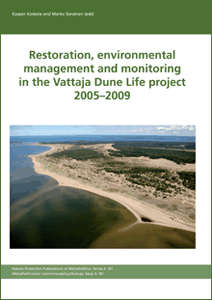Restoration, environmental management and monitoring in the Vattaja Dune LIFE project 2005-2009
Vattajanniemi is an area in Europe containing boreal zone dune habitat types. It is also one of the Finnish Defence Forces’ most important training areas and a popular recreational area. To reconcile the various uses and natural values, a LIFE project funded by the EU was implemented in the area during 2005–2009. This publication includes a summary of the reports drawn up during the project, concerning the area’s natural values and use.
This summary includes:
- a description of the most important habitat types and species in Vattaja and their status
- a look at the mechanism through which dunes form and the factors affecting the flora and fauna of the Vattaja dune area
- a description of the land-use history and present use of the Vattaja dune area
- a specification of the threats caused by land use for the natural values and their formation mechanisms, especially activities causing erosion of the dunes
- a specification of the factors threatening the area’s other natural values
- a description of the adaptation of the Defence Forces’ operations to the area’s natural values
- a presentation of the restoration and maintenance measures for open sand habitats, damaged dunes, traditional rural biotopes, mires and forests as well as minor bodies of water.
All of the six dune habitat types in Finland, defined in the EU Nature Directive’s Appendix I, can be found in Vattaja exceptionally extensively. The area’s expansiveness allows for wind and the movement of sand, essential to the natural disturbance dynamics of dunes, which allows succession to continue to take place in the area. Vattaja’s natural values are supplemented by small-scale paludified areas, wetlands and traditional rural biotopes formed through long-term grazing. Especially species of butterfly which are dependent on moving sand are known to be significant in the area.
The erosion of the dunes through the Defence Forces’s training, but also through recreational use to a lesser extent, forms the most significant threat to the eolian sand area’s delicate natural values. The signs of land use are visible in places as substantial damage to the dune habitat. The most important threat, apart from this, is the end of traditional land use and the overgrowth of the open shoreline habitats, caused by the eutrophication of the Baltic Sea.
The eroding effects on the terrain have been minimised during the LIFE project by, for example, moving the Defence Forces’ firing positions away from the most important dune areas, by standardising the access routes and locations of practice facilities, by increasing the facilities directing recreational use and by drawing up information material for recreational users and the Defence Forces. A wide range of environmental management and restoration plans for various biotopes have been drawn up and completed during the LIFE project: damaged dune formations, open sand areas which are overgrown and under excess erosion, traditional rural biotopes, mires and forests as well as gloes have been provided with their own specialised plans. The reports and plans drawn up during the LIFE project form the foundation for the Vattajanniemi Natura 2000 area’s long-term maintenance and use planning.

Julkaisu on tiivistelmä suomeksi ilmestyneestä “Ennallistaminen, luonnonhoito ja seuranta Vattajan Dyyni Life-hankkeessa 2005–2009” -julkaisusta (Sarja A 180).